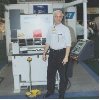Emerging Trends in Press Brake Automation
Paul LeTang of LVD Strippit explains how press brake automation is moving toward the eventual outcome of a system where piece cost is the same, no matter how large the batch size, and setup up time is effectively eliminated.
Posted: May 13, 2013
Press brake automation is moving toward the eventual outcome of a system where piece cost is the same, no matter how large the batch size, and setup up time is effectively eliminated.
The focus for press brake manufacturers and press brake users continues to be centered on how to effectively address the need for smaller lot sizes. Emerging trends in press brake automation are responding to this requirement and offering solutions that are cost-efficient and easy to use.
Conventional automation, both hard and flexible, can be applied to any forming process. The justification has been in the quantity and, more recently, in the “life cycle” of the product. High volume and its inherent large batch sizes, ideal for hard automation, are in decline around the world.
In fact, in markets with high labor rates, large batch sizes have virtually disappeared. This leaves flexible press brake automation as the most viable option for most applications.
However, because of the complexity of applying flexible automation to many different part shapes, long product life cycles are needed for amortization of cost. This is the primary reason few robot press brakes are in use today. Consequently, press brake automation is trending in a different direction.
Individual system components are being optimized to effectively address current market demands. The machine operator is still handling the parts, but, using current press brake technology, setup times are reduced and can average three minutes or less.
Machine interfaces, such as touch screen controls, are more user friendly than ever before and are beginning to look and function like cell phones. This is probably the most significant paradigm shift from the conventional proprietary machine control language that only a highly skilled operator could understand. Today, an entire generation feels at home in front of an icon-driven touch screen.
Powerful applications are also evolving, including automatic tool shape selection, bend allowance databases, bend order calculations, interference identification, ram cycle optimization, and others. The press brake operator no longer has to address application issues.
For example, to bend a one inch flange at 90 deg on an edge that is 30 in long, the operator simply keys in the information and the machine configuration to produce that result is calculated and automatically created.
Mechanical features are also becoming a more important part of automating the bending process. Because press brakes are becoming so easy to program, many are programmed off-line, so mechanical features such as quick change tooling, power tool clamping, plate pushers and plate lifters not only contribute to overall throughput but aid with lifting and pushing tasks performed by the operator.
Automatic angle measurement and automatic angle correction are also taking center stage. Many press brake manufacturers now offer some type of adaptive forming system. These systems make in-process angle corrections and also ensure the first part is a good part. The adaptive forming feature is critical for “kit” or one-piece-flow applications.
The final frontier in press brake automation is press brake tool changing. Small quantity part runs usually mean more tool setups per day. An automated press brake tool changing system reduces tool setup time and improves manufacturing efficiency.
Trends in press brake automation are moving toward the eventual outcome of a system where piece cost is the same, no matter the batch size, and setup up time is effectively eliminated.




